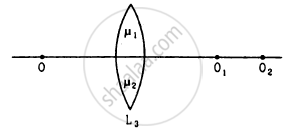Advertisements
Advertisements
Question
Two lenses A and B have focal lengths of +20 cm and, −10 cm, respectively.
(a) What is the nature of lens A and lens B?
(b) What is the power of lens A and lens B?
(c) What is the power of combination if lenses A and B are held close together?
Solution
(a) The focal length of lens A is +20 cm. The positive sign indicates that lens A is convex, i.e., a converging lens.
The focal length of lens B is -10 cm. The negative sign indicates that lens B is concave, i.e., a diverging lens.
(b) Focal length of lens A, fA = +20 cm = +0.20 m
∴ Power of lens `A, P_A=1/(f_A)=1/0.20=5D`
Focal length of lens B, fB = -10 cm = -0.10 m
∴ Power of lens B, `P_B=1/f_b=1/-0.10=-10D`
(c) When lenses are combined, the power of the combination is the algebraic sum of the powers of the individual lenses.
∴ Power of combination of lens A and B,p=P_A=P_B
` P=5D-10D=-5D.`
APPEARS IN
RELATED QUESTIONS
A convex lens forms a real and inverted image of a needle at a distance of 50 cm from it. Where is the needle placed in front of the convex lens if the image is equal to the size of the object? Also, find the power of the lens.
Find the focal length of a lens of power −2.0 D. What type of lens is this?
A student uses a lens of focal length 40 cm and another of –20 cm. Write the nature and power of each lens
What is the power of a convex lens of focal length 0.5 m?
Find the radius of curvature of the convex surface of a plano-convex lens, whose focal length is 0.3 m and the refractive index of the material of the lens is 1.5.
Consider three converging lenses L1, L2 and L3 having identical geometrical construction. The index of refraction of L1 and L2 are \[\mu_1 \text{ and } \mu_2\] respectively. The upper half of the lens L3 has a refractive index \[\mu_1\] and the lower half has \[\mu_2\] following figure . A point object O is imaged at O1 by the lens L1 and at O2 by the lens L2placed in same position. If L3 is placed at the same place,
(a) there will be an image at O1
(b) there will be an image at O2.
(c) the only image will form somewhere between O1 and O2
(d) the only image will form away from O2.
A 5.0 diopter lens forms a virtual image which is 4 times the object placed perpendicularly on the principal axis of the lens. Find the distance of the object from the lens.
How is accommodation produced?
Power of a lens is – 4D, then its focal length is
The power of lens depends on the focal length of the lens
